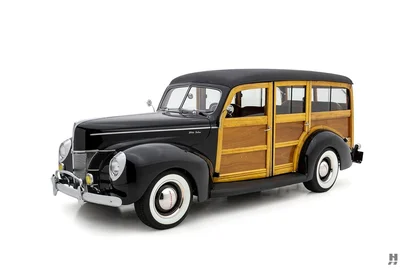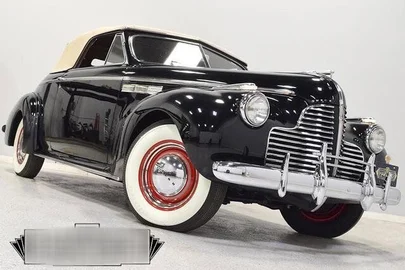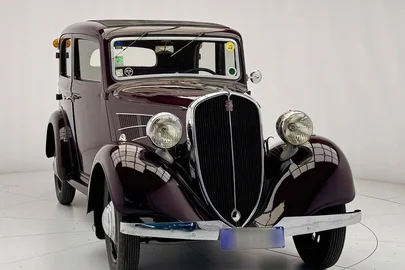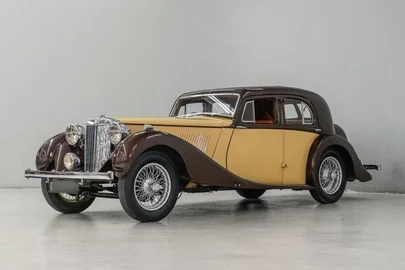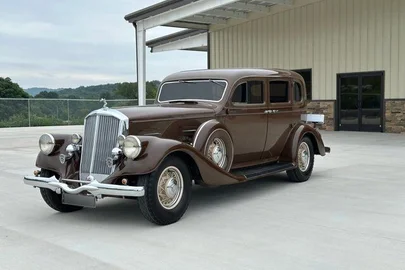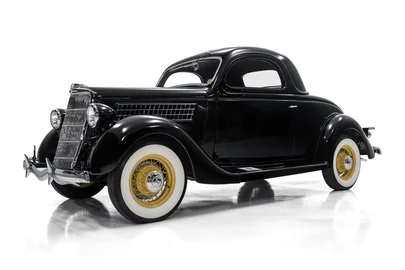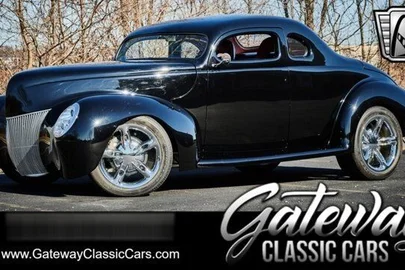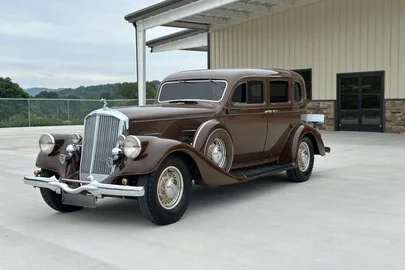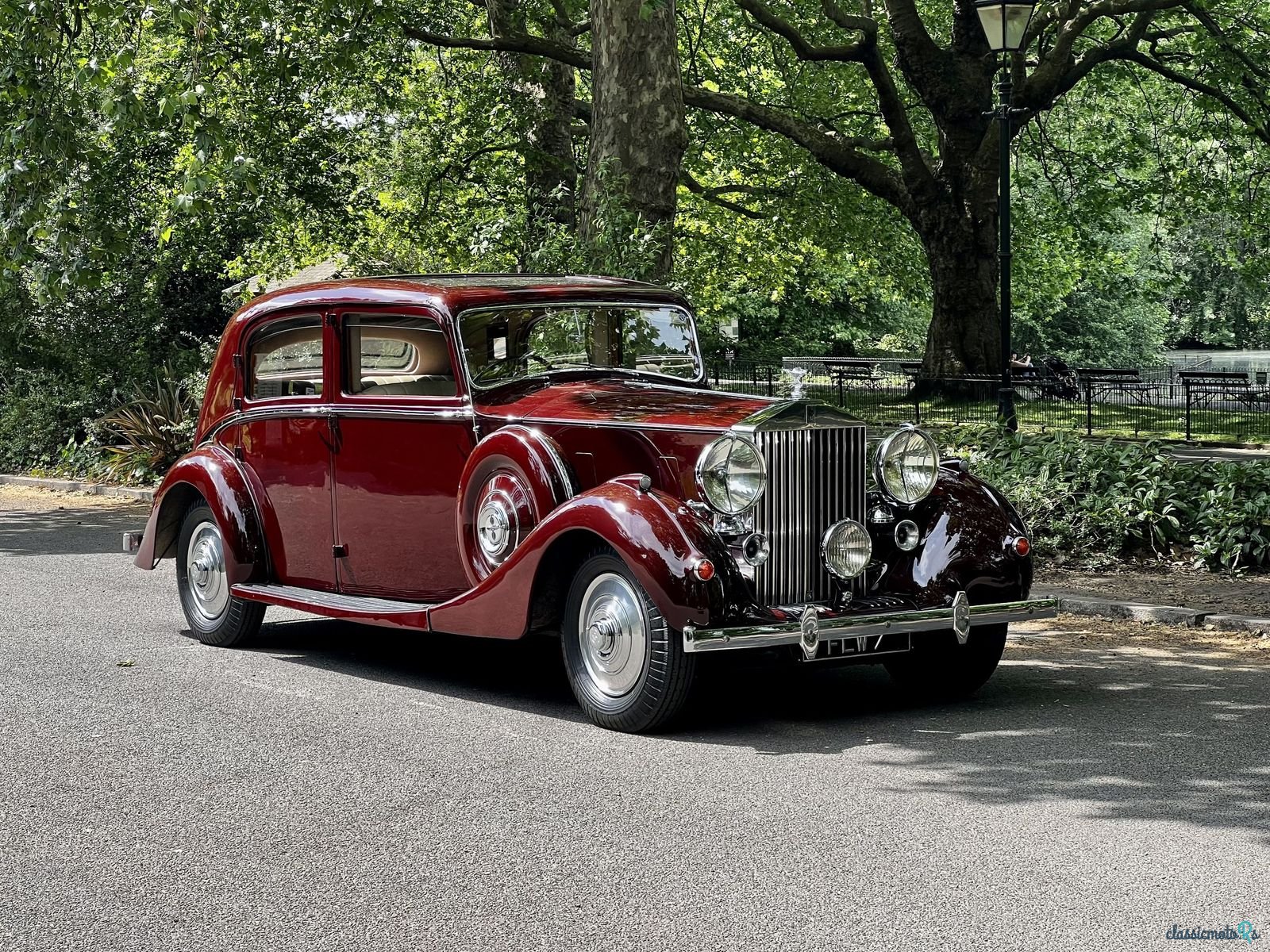
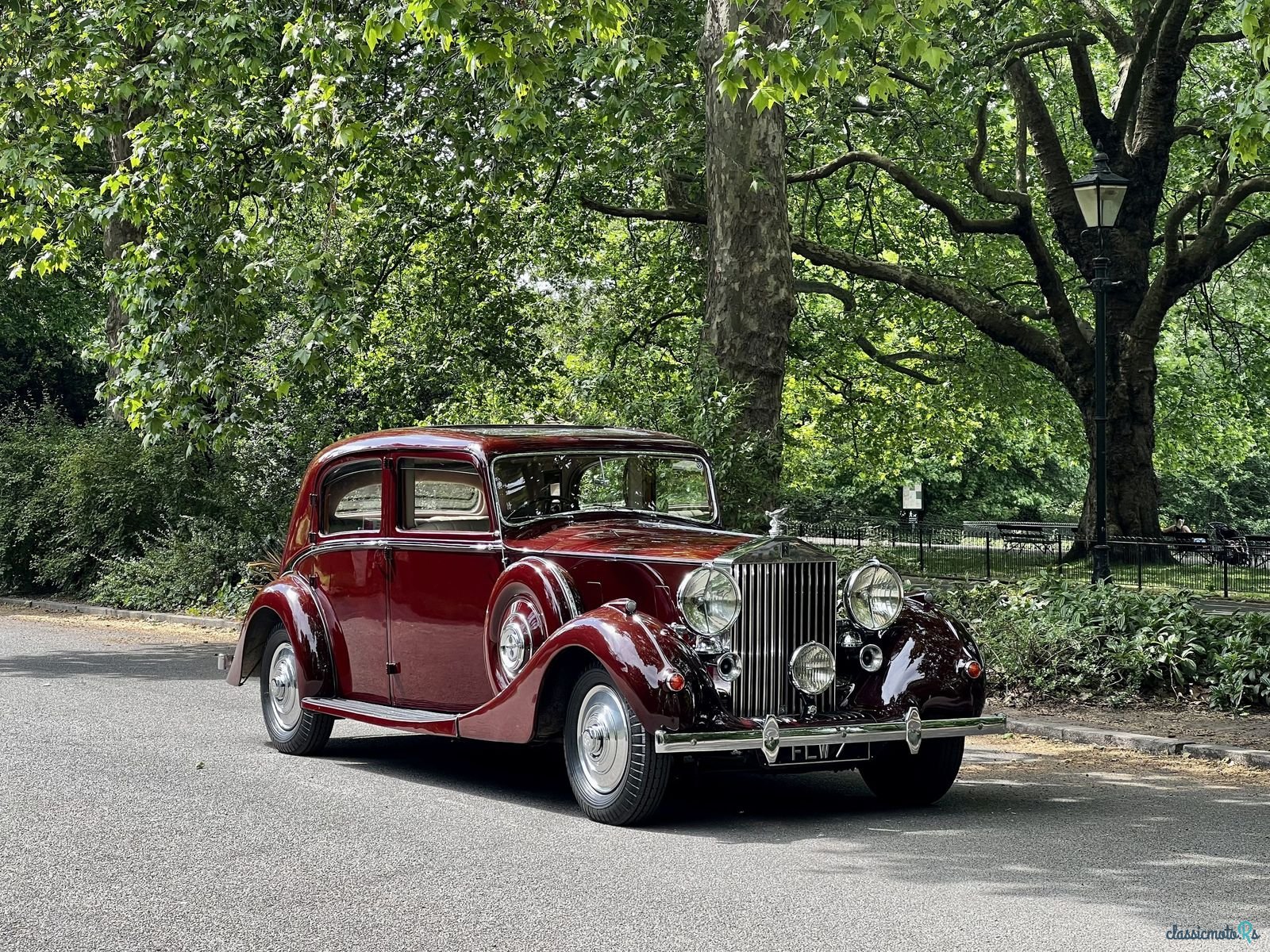
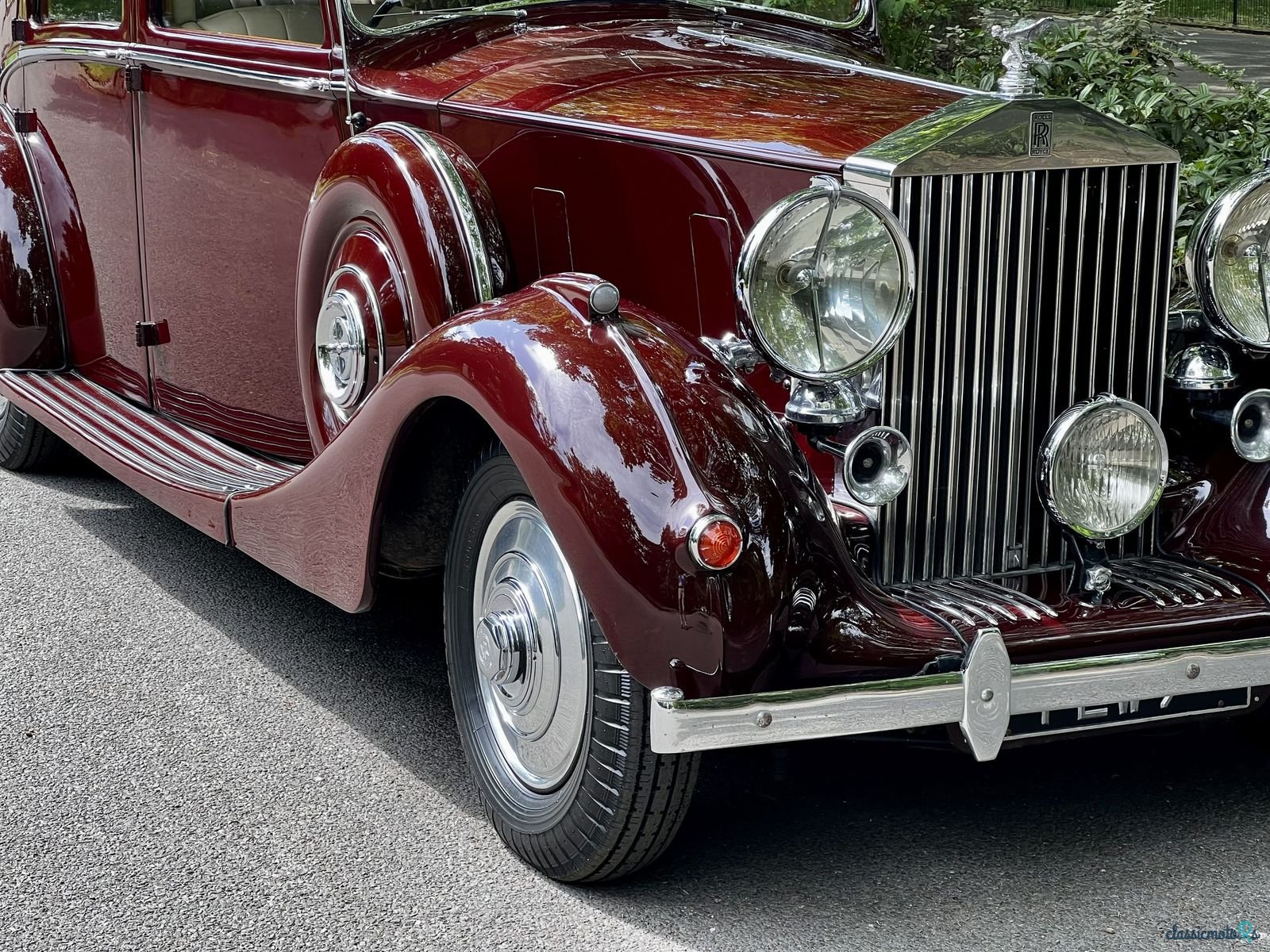
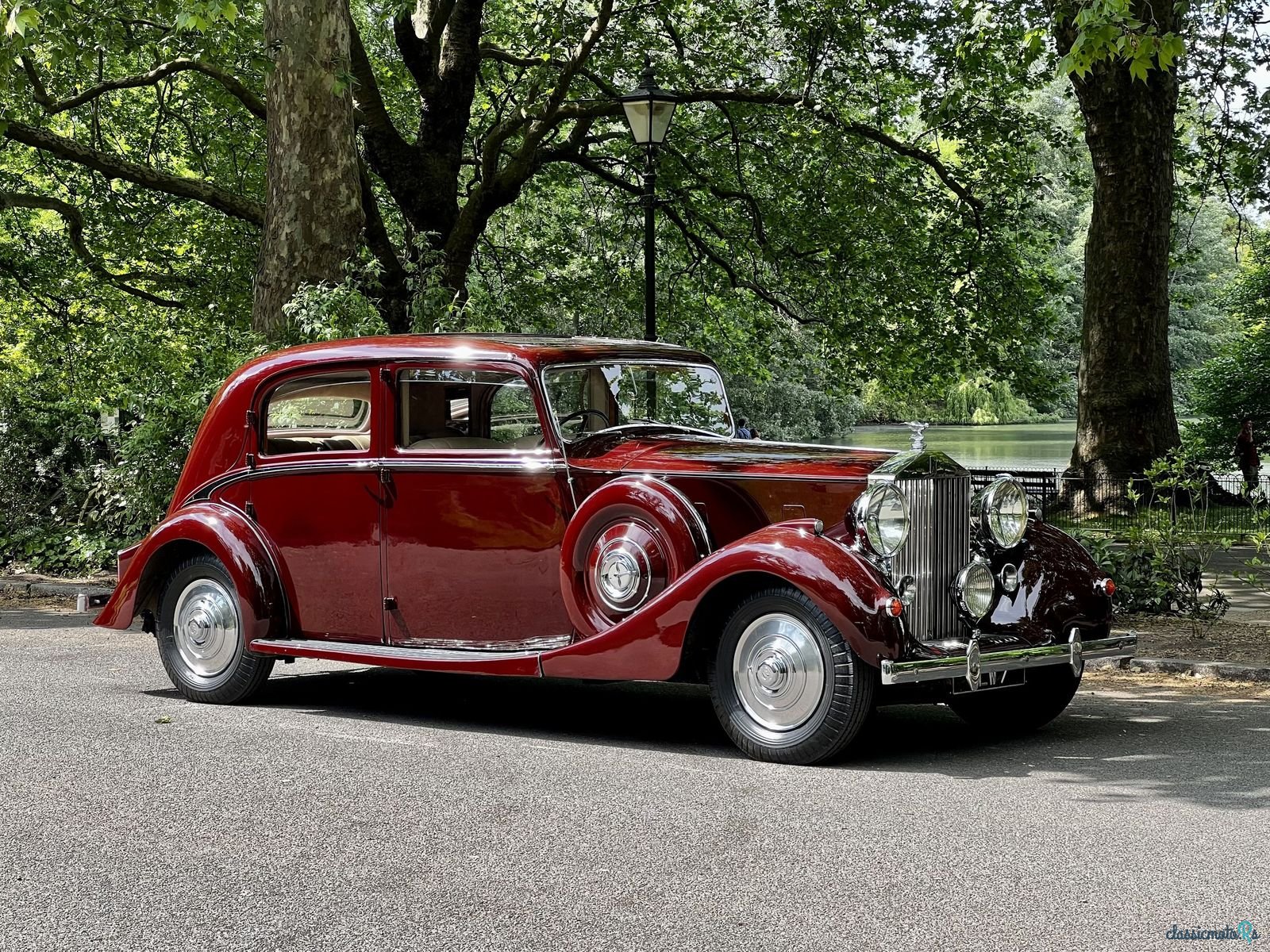
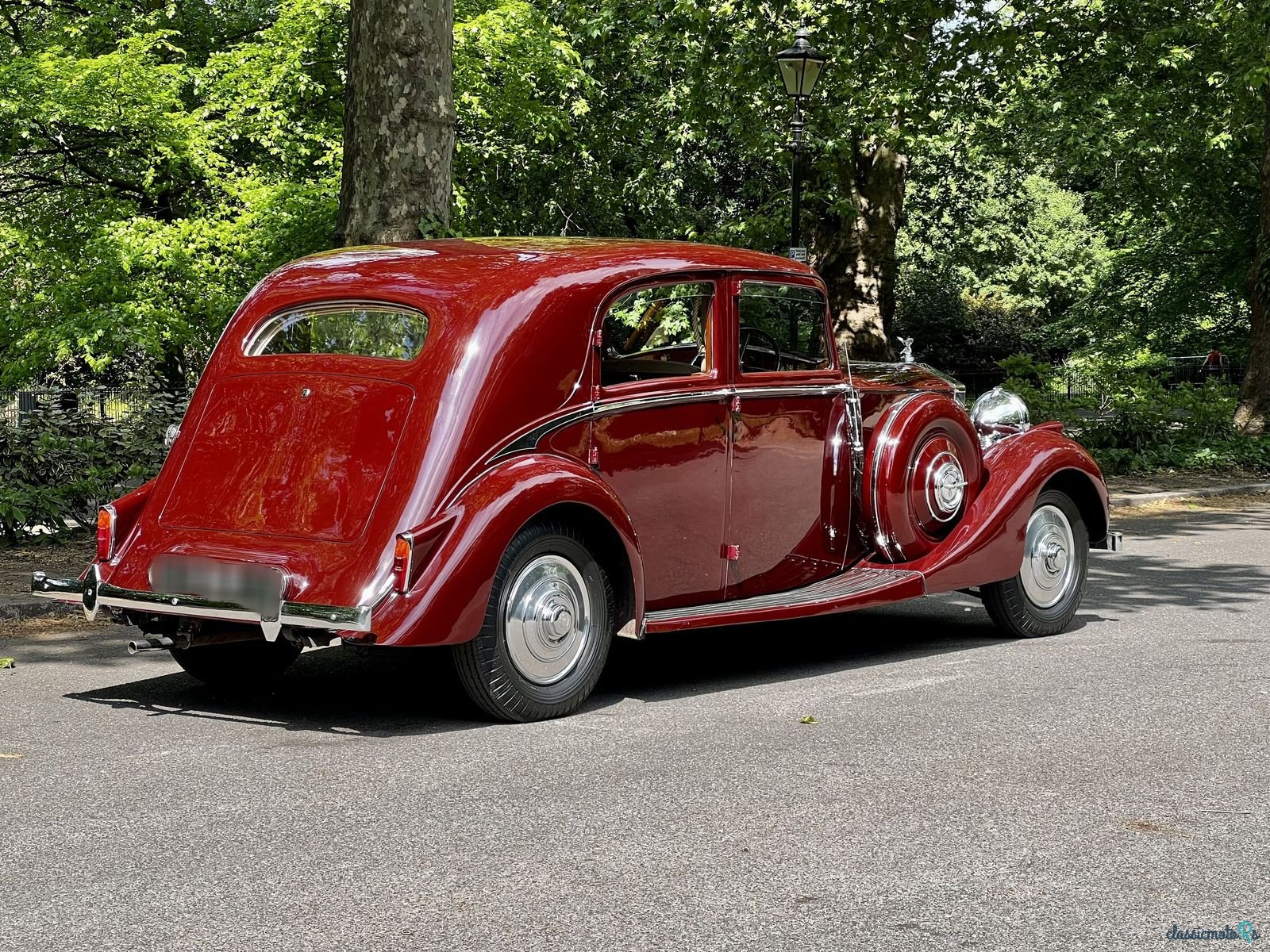
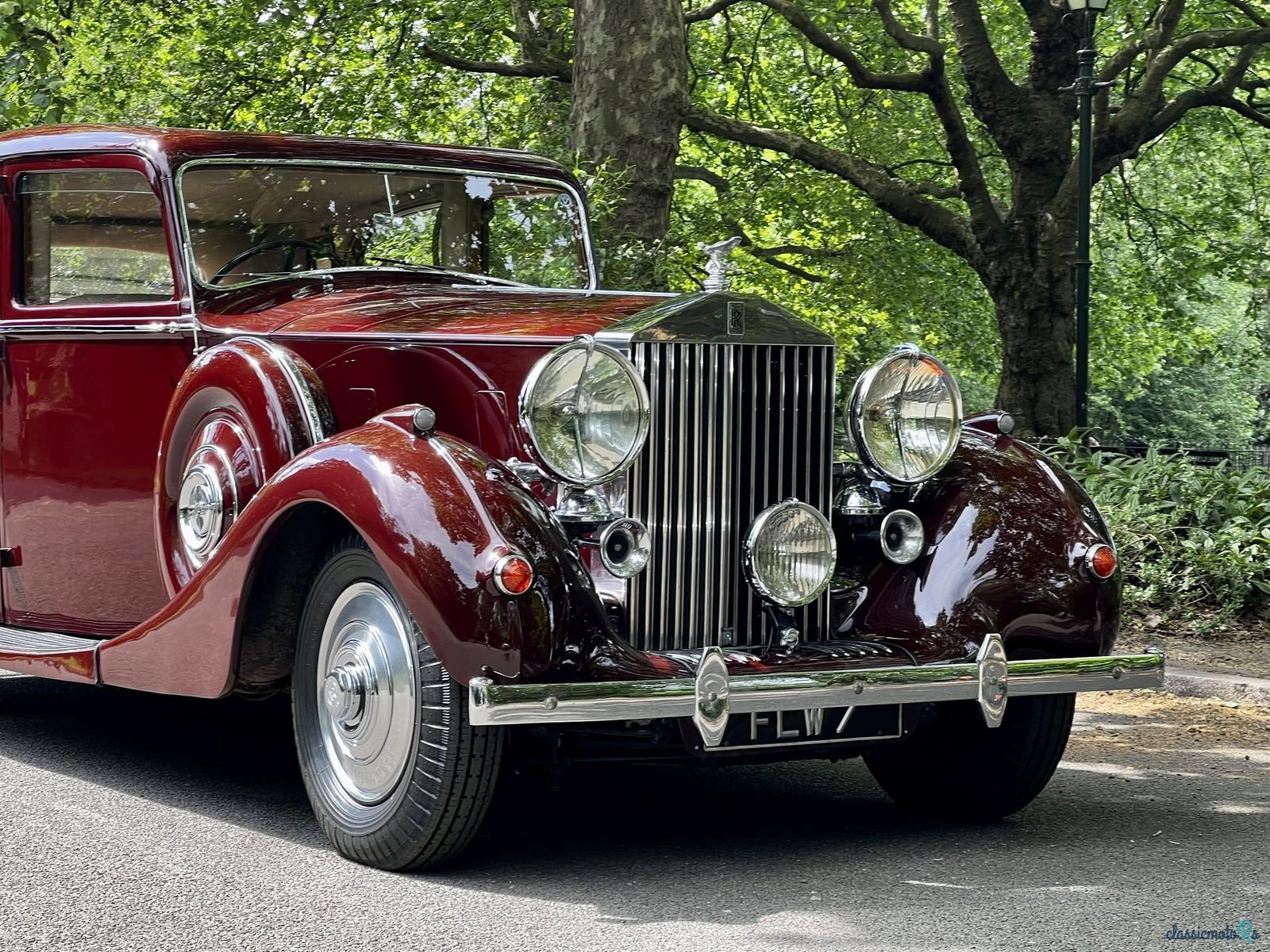
6 photos
1939' Rolls-Royce Silver Wraith
Report This Ad!Rate This!Bookmark This
£97,500Published 5 July 2023ID: M9O0W7
Expired
2 years, 5 months ago
2 years, 5 months ago
Information from the owner
Age: 84 years
Exterior color: Brown
Electronics: AM/FM Radio
Seller's comments about 1939' Rolls-Royce Silver Wraith
Chassis Number: WMB 11 Engine Number: WXA 1 Registration Number: FLW 7
Highlights:
• Built for Rolls-Royce's managing director – Sir Arthur F. Sidgreaves OBE - with input from the Rolls-Royce Experimental Department*
• Sidgreaves requested that 'FLW 7' feature an uprated engine (carried over from his previous Wraith chassis WXA1)*
• With the engine including some Bentley Mk V modifications a 1939 comparison with a standard Wraith showed WMB 7 to produce 10% more power and as an “experimental car”, was “significantly lighter”*
• Bodied as a lightweight Special Saloon by Park Ward using a steel support frame with aluminium panels and wings*
• Fitted with an electric division, Perspex roof over the driver / front passenger, Smiths 'Hades' heater, Philco radio set and leather upholstery (detailed in letter to Park Ward dated 12 January 1939)
• Post War owned by three Rolls-Royce directors - Baron Ernest Hives, Chairman of Rolls-Royce; Captain Eric Smith, Chairman Rolls-Royce; and A G Elliot, Joint Managing Director, Rolls-Royce
• Subsequently owned by Sir Frederick Arthur Montague “Boy” Browning, the husband of the novelist Daphne du Maurier, Sir Brian Warren, physician to Winston Churchill and Ted Heath, and Dame Josephine Barnes, the first woman President of the British Medical Association
• Recently extensively recommissioned, painted in corniche maroon and re-trimmed.
* Source: “The Rolls-Royce Wraith” by Tom C Clarke published in 1986
The Wraith was ordered by Sir Arthur F Sidgreaves OBE, Chairman of Rolls-Royce, who took delivery of chassis WMB 11 in 1939.
He specified that it be fitted with the engine from his current Wraith chassis WXA 1 and additionally ordered the transfer of the radio and clock to his new car. The engine is closely related to the Bentley MK V unit along with the rest of the cars running gear and was frequently fitted with new developments that Sidgreaves tested personally during the period he had the car. The car was truly an experimental car and the way that things were ordered by the heads or managers of each department on the chassis cards suggest he was not the easiest person to please.
The Park Ward special body fitted has no wooden frame. It has a steel base attached to the chassis and then an all alloy body fitted.
Sidgreaves had worked previously as export manager with Napier prior to joining Rolls-Royce and eventually became Managing Director of Rolls-Royce for a 17 year period managing the company prior, throughout and post WW2. He used FLW 7 as his own car up until 1945. He was one not to be crossed and was a formidable businessman who purchased the assets of W. O. Bentley for Rolls-Royce from under the noses of Napier. He had the foresight to join forces with Sir Robert Mclean of Vickers to manufacture the Spitfire.
Sidgreaves was credited by 'The Times' newspaper with "doing more than any other man to deliver the tools with which the RAF won the Battle of Britain."
The next custodian, in 1946, was Baron Ernest Hives Chairman of Rolls-Royce, a very significant figure in the history of the Company. After becoming a chief test driver in 1908, he led the Rolls-Royce team in the Austrian Alpine Trial in 1913. During the First World War the company designed its' first aero-engine and Hives developed it successfully, by 1916 he was Head of the Experimental Department. Other notable engines were later developed under Hives' lead, including the Buzzard, R Series and the Merlin. In 1936 he became the general works manager of the factory and a year later was elected to the board. In 1937, thinking war would soon be inevitable, he prepared the firm for a massive production increase in Merlin engines by splitting facilities between engineering and production. As the Merlin powered Hurricanes and Spitfires, this was a decision of vital strategic significance when war did come. It was thanks to Hives that a total of a hundred and sixty thousand Merlins were produced by 1945. In 1941 Hives quickly decided 'to go all out for the gas turbine, ensuring the company's leading role in developing jet engines for civil and military aviation.
Vice Chief of Air Staff Sir Wilfrid Freeman, one of the masterminds behind the dramatic advances in British aircraft production before and during World War 2, paid tribute to Hives's dedication in a letter to his wife: “That man Hives is the best man I have ever come across for many a year. God knows where the RAF would have been without him. He cares for nothing except the defeat of Germany and he does all his work to that end, living a life of unending labour.”
Hives became managing director in 1946 and chairman of Rolls-Royce from 1950 till 1957. He was made a Companion of Honour in 1943 and on 7 July 1950 he was raised to the peerage as Baron Hives, of Duffield in the County of Derby.
The next owner was Captain Eric Smith, Chairman Rolls-Royce, whose daughter Fortune was awarded the title “Her Grace the Dowager Duchess of Grafton” by HM the Queen in 2011.
The final Rolls-Royce director to own the car was A G Elliot up until 1951. Elliott joined Rolls-Royce from Napier and became chief engineer for the aero engine division whilst being the personnel assistant to Sir Henry Royce and thereafter the joint Managing Director of Rolls-Royce along with Baron Ernest Hives and then Executive Vice Chairman.
In 1951 the car was then purchased by Sir Frederick Arthur Montague “Boy” Browning whose address was given as Buckingham Palace, London SW1. Browning owned the car up until 1954. During this period he was comptroller and treasurer to HRH Princess Elizabeth and then after their marriage became treasurer to the office of Prince Phillip after being recommended by Louis Mountbatten. He was the husband of the novelist Daphne du Maurier. At the end of WW2 Browning negotiated with and accepted the surrender of the Japanese whilst his then superior Dwight Eisenhower signed the official documents in front of the worlds media. During the hostilities he was promoted to Lt General and was instrumental in starting the Airborne corps or as we know it now, the parachute regiment, from whom spawned during that period the SAS. He was named “Boy” Browning due to his boyish looks and many books have been written on his life. HM Queen Elizabeth and the Prince Phillip would travel to Menabilly, Browning and du Maurier's country home, along with Prince Charles and Princess Anne in the fifties and the Duke would go sailing with Boy. It is probable that they used the Wraith at this time.
The car then passed to Sir Brian Warren of Chester Square, London W1, until 1961. Another fascinating man who looked after Sir Winston Churchill's health whilst in Downing Street and then became the personal physician to Prime Minister Ted Heath.
The next owner was Dame Josephine Barnes of Chester Square, London W1, until 1963. She became the first woman President of the British Medical Association.
It was then owned by Mr L Scull of Nottingham until 1974 before being bought by the late Professor Ken Britten. Amongst his many important personal engineering achievements, Britten invented the heated windscreen glass and produced gyroscopes for the first ballistic missiles for the U. S. A.
Following the death of Professor Britten FLW 7 was purchased by S Willkie in 2013. According to Wilkie “Ken Britten had gone through the running gear and chassis so it was a relatively simple task to drop the sump and lift the head and to see that the engine was beautifully done. The radiator was renewed, the chrome redone and the body stripped and repainted in solid maroon colour. The interior was too far gone so everything was virtually remade but fortunately the wood was in remarkably good condition, so was repolished. The Perspex sunroof was also renewed.
Words above are from the last owner of FLW 7, who has a fine selection of motorcars, many of which are used for racing. Obviously FLW 7 is not suitable for that, although the manner in which he has been built and modified in period by the engineers of the RR factory, she is indeed a very fast car for her period. Just sitting inside her the thinking of all the men and women who had driven or been driven in her brings the hairs on the back of my neck to stand up. I have been in many an historical motorcar, but I'm not sure one as impressive as this.
A beautiful body with sleek and delicate lines, with an interior with superb art decor features leaves one in mind of the period of decadence whilst just around the corner war was about to start and the RR factory would be heavily involved in this for the next 6 years - and the men behind this were all owners and users of this very motorcar. Mind boggling what they had to endure and what they achieved too.
This motorcar is a testament to them and those who built her too. Whoever buys this will be a very lucky person indeed.
Highlights:
• Built for Rolls-Royce's managing director – Sir Arthur F. Sidgreaves OBE - with input from the Rolls-Royce Experimental Department*
• Sidgreaves requested that 'FLW 7' feature an uprated engine (carried over from his previous Wraith chassis WXA1)*
• With the engine including some Bentley Mk V modifications a 1939 comparison with a standard Wraith showed WMB 7 to produce 10% more power and as an “experimental car”, was “significantly lighter”*
• Bodied as a lightweight Special Saloon by Park Ward using a steel support frame with aluminium panels and wings*
• Fitted with an electric division, Perspex roof over the driver / front passenger, Smiths 'Hades' heater, Philco radio set and leather upholstery (detailed in letter to Park Ward dated 12 January 1939)
• Post War owned by three Rolls-Royce directors - Baron Ernest Hives, Chairman of Rolls-Royce; Captain Eric Smith, Chairman Rolls-Royce; and A G Elliot, Joint Managing Director, Rolls-Royce
• Subsequently owned by Sir Frederick Arthur Montague “Boy” Browning, the husband of the novelist Daphne du Maurier, Sir Brian Warren, physician to Winston Churchill and Ted Heath, and Dame Josephine Barnes, the first woman President of the British Medical Association
• Recently extensively recommissioned, painted in corniche maroon and re-trimmed.
* Source: “The Rolls-Royce Wraith” by Tom C Clarke published in 1986
The Wraith was ordered by Sir Arthur F Sidgreaves OBE, Chairman of Rolls-Royce, who took delivery of chassis WMB 11 in 1939.
He specified that it be fitted with the engine from his current Wraith chassis WXA 1 and additionally ordered the transfer of the radio and clock to his new car. The engine is closely related to the Bentley MK V unit along with the rest of the cars running gear and was frequently fitted with new developments that Sidgreaves tested personally during the period he had the car. The car was truly an experimental car and the way that things were ordered by the heads or managers of each department on the chassis cards suggest he was not the easiest person to please.
The Park Ward special body fitted has no wooden frame. It has a steel base attached to the chassis and then an all alloy body fitted.
Sidgreaves had worked previously as export manager with Napier prior to joining Rolls-Royce and eventually became Managing Director of Rolls-Royce for a 17 year period managing the company prior, throughout and post WW2. He used FLW 7 as his own car up until 1945. He was one not to be crossed and was a formidable businessman who purchased the assets of W. O. Bentley for Rolls-Royce from under the noses of Napier. He had the foresight to join forces with Sir Robert Mclean of Vickers to manufacture the Spitfire.
Sidgreaves was credited by 'The Times' newspaper with "doing more than any other man to deliver the tools with which the RAF won the Battle of Britain."
The next custodian, in 1946, was Baron Ernest Hives Chairman of Rolls-Royce, a very significant figure in the history of the Company. After becoming a chief test driver in 1908, he led the Rolls-Royce team in the Austrian Alpine Trial in 1913. During the First World War the company designed its' first aero-engine and Hives developed it successfully, by 1916 he was Head of the Experimental Department. Other notable engines were later developed under Hives' lead, including the Buzzard, R Series and the Merlin. In 1936 he became the general works manager of the factory and a year later was elected to the board. In 1937, thinking war would soon be inevitable, he prepared the firm for a massive production increase in Merlin engines by splitting facilities between engineering and production. As the Merlin powered Hurricanes and Spitfires, this was a decision of vital strategic significance when war did come. It was thanks to Hives that a total of a hundred and sixty thousand Merlins were produced by 1945. In 1941 Hives quickly decided 'to go all out for the gas turbine, ensuring the company's leading role in developing jet engines for civil and military aviation.
Vice Chief of Air Staff Sir Wilfrid Freeman, one of the masterminds behind the dramatic advances in British aircraft production before and during World War 2, paid tribute to Hives's dedication in a letter to his wife: “That man Hives is the best man I have ever come across for many a year. God knows where the RAF would have been without him. He cares for nothing except the defeat of Germany and he does all his work to that end, living a life of unending labour.”
Hives became managing director in 1946 and chairman of Rolls-Royce from 1950 till 1957. He was made a Companion of Honour in 1943 and on 7 July 1950 he was raised to the peerage as Baron Hives, of Duffield in the County of Derby.
The next owner was Captain Eric Smith, Chairman Rolls-Royce, whose daughter Fortune was awarded the title “Her Grace the Dowager Duchess of Grafton” by HM the Queen in 2011.
The final Rolls-Royce director to own the car was A G Elliot up until 1951. Elliott joined Rolls-Royce from Napier and became chief engineer for the aero engine division whilst being the personnel assistant to Sir Henry Royce and thereafter the joint Managing Director of Rolls-Royce along with Baron Ernest Hives and then Executive Vice Chairman.
In 1951 the car was then purchased by Sir Frederick Arthur Montague “Boy” Browning whose address was given as Buckingham Palace, London SW1. Browning owned the car up until 1954. During this period he was comptroller and treasurer to HRH Princess Elizabeth and then after their marriage became treasurer to the office of Prince Phillip after being recommended by Louis Mountbatten. He was the husband of the novelist Daphne du Maurier. At the end of WW2 Browning negotiated with and accepted the surrender of the Japanese whilst his then superior Dwight Eisenhower signed the official documents in front of the worlds media. During the hostilities he was promoted to Lt General and was instrumental in starting the Airborne corps or as we know it now, the parachute regiment, from whom spawned during that period the SAS. He was named “Boy” Browning due to his boyish looks and many books have been written on his life. HM Queen Elizabeth and the Prince Phillip would travel to Menabilly, Browning and du Maurier's country home, along with Prince Charles and Princess Anne in the fifties and the Duke would go sailing with Boy. It is probable that they used the Wraith at this time.
The car then passed to Sir Brian Warren of Chester Square, London W1, until 1961. Another fascinating man who looked after Sir Winston Churchill's health whilst in Downing Street and then became the personal physician to Prime Minister Ted Heath.
The next owner was Dame Josephine Barnes of Chester Square, London W1, until 1963. She became the first woman President of the British Medical Association.
It was then owned by Mr L Scull of Nottingham until 1974 before being bought by the late Professor Ken Britten. Amongst his many important personal engineering achievements, Britten invented the heated windscreen glass and produced gyroscopes for the first ballistic missiles for the U. S. A.
Following the death of Professor Britten FLW 7 was purchased by S Willkie in 2013. According to Wilkie “Ken Britten had gone through the running gear and chassis so it was a relatively simple task to drop the sump and lift the head and to see that the engine was beautifully done. The radiator was renewed, the chrome redone and the body stripped and repainted in solid maroon colour. The interior was too far gone so everything was virtually remade but fortunately the wood was in remarkably good condition, so was repolished. The Perspex sunroof was also renewed.
Words above are from the last owner of FLW 7, who has a fine selection of motorcars, many of which are used for racing. Obviously FLW 7 is not suitable for that, although the manner in which he has been built and modified in period by the engineers of the RR factory, she is indeed a very fast car for her period. Just sitting inside her the thinking of all the men and women who had driven or been driven in her brings the hairs on the back of my neck to stand up. I have been in many an historical motorcar, but I'm not sure one as impressive as this.
A beautiful body with sleek and delicate lines, with an interior with superb art decor features leaves one in mind of the period of decadence whilst just around the corner war was about to start and the RR factory would be heavily involved in this for the next 6 years - and the men behind this were all owners and users of this very motorcar. Mind boggling what they had to endure and what they achieved too.
This motorcar is a testament to them and those who built her too. Whoever buys this will be a very lucky person indeed.
